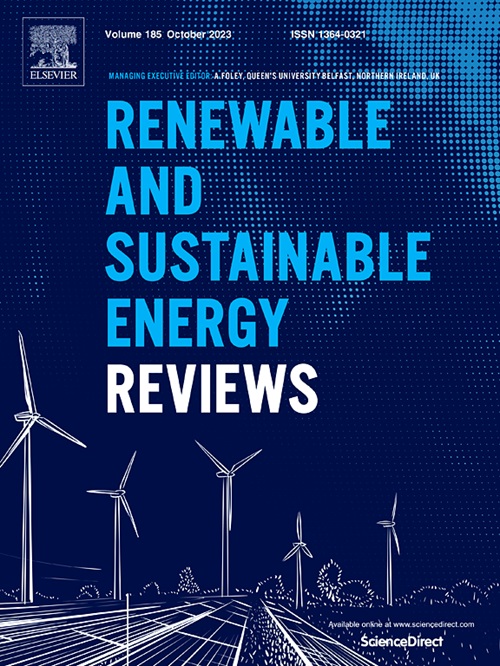Methodological approaches for resource recovery from end-of-life panels of different generations of photovoltaic technologies – A review
IF 16.3
1区 工程技术
Q1 ENERGY & FUELS
引用次数: 0
Abstract
The rise in prominence of solar energy as a green technology demanded economical and sustainable waste management due to the anticipated surge of end-of-life panel waste streams. While there are many advantages to the increase in solar power output, end-of-life solar panels could become a source of hazardous waste. Therefore, the disposal of photovoltaic panels will become a major environmental concern in the next decades. Generations of photovoltaic technologies, namely crystalline silicon, thin-film, and third-generation solar panels, share the goal of achieving waste reduction through useful strategies for recovery of secondary raw materials from obsolete panels. This research reviews the current status and future prospects for valuable constituents, waste projections, and trends in technological advances for recycling and recovery of resource materials from different generations of photovoltaic solar systems. Projections of global photovoltaic waste driven by the expansion of solar system installations illuminate the influx of waste streams that burden the environment if there are no measures in place for sustainable waste management. The crystalline silicon and thin-film PV technologies have demonstrated sufficient advancements in resource recovery technologies for industrial use in circular economy and closed-loop recycling to minimize environmental impacts and prevent leaching of toxic elements. Industrial application of pyrolysis and chemical etching has emerged as a promising approach to recovery of high-purity secondary valuable materials from obsolete c-Si panels. Substantial recoveries of critical from obsolete thin-film panels are notable with the application of mechanical and hydrometallurgical waste treatment techniques. Third-generation waste treatment methods are largely based on laboratory experiments because these solar systems are on the verge of commercialization.

从不同代光伏技术的报废电池板中回收资源的方法 - 综述
由于预计报废太阳能电池板废物流会激增,太阳能作为一种绿色技术的重要性日益凸显,这就要求进行经济、可持续的废物管理。虽然太阳能发电量的增加有很多好处,但报废太阳能电池板可能成为有害废物的来源。因此,光伏电池板的处理将成为未来几十年的主要环境问题。各代光伏技术,即晶体硅、薄膜和第三代太阳能电池板,都有一个共同的目标,即通过从报废电池板中回收二次原材料的有效策略来实现减少废物的目标。本研究回顾了有价值成分的现状和未来前景、废物预测以及从不同代光伏太阳能系统中回收和循环利用资源材料的技术进步趋势。随着太阳能系统安装量的增加,对全球光伏废物的预测表明,如果不采取可持续废物管理措施,废物流将大量涌入,给环境造成负担。晶体硅和薄膜光伏技术在资源回收技术方面取得了足够的进步,可用于循环经济和闭环回收的工业用途,从而最大限度地减少对环境的影响,防止有毒元素的沥滤。热解和化学蚀刻的工业应用已成为从废弃晶体硅电池板中回收高纯度二次有价材料的一种有前途的方法。应用机械和湿法冶金废物处理技术从废弃的薄膜面板中大量回收关键材料的效果显著。第三代废物处理方法主要基于实验室实验,因为这些太阳能系统即将商业化。
本文章由计算机程序翻译,如有差异,请以英文原文为准。
求助全文
约1分钟内获得全文
求助全文
来源期刊

Renewable and Sustainable Energy Reviews
工程技术-能源与燃料
CiteScore
31.20
自引率
5.70%
发文量
1055
审稿时长
62 days
期刊介绍:
The mission of Renewable and Sustainable Energy Reviews is to disseminate the most compelling and pertinent critical insights in renewable and sustainable energy, fostering collaboration among the research community, private sector, and policy and decision makers. The journal aims to exchange challenges, solutions, innovative concepts, and technologies, contributing to sustainable development, the transition to a low-carbon future, and the attainment of emissions targets outlined by the United Nations Framework Convention on Climate Change.
Renewable and Sustainable Energy Reviews publishes a diverse range of content, including review papers, original research, case studies, and analyses of new technologies, all featuring a substantial review component such as critique, comparison, or analysis. Introducing a distinctive paper type, Expert Insights, the journal presents commissioned mini-reviews authored by field leaders, addressing topics of significant interest. Case studies undergo consideration only if they showcase the work's applicability to other regions or contribute valuable insights to the broader field of renewable and sustainable energy. Notably, a bibliographic or literature review lacking critical analysis is deemed unsuitable for publication.
 求助内容:
求助内容: 应助结果提醒方式:
应助结果提醒方式:


